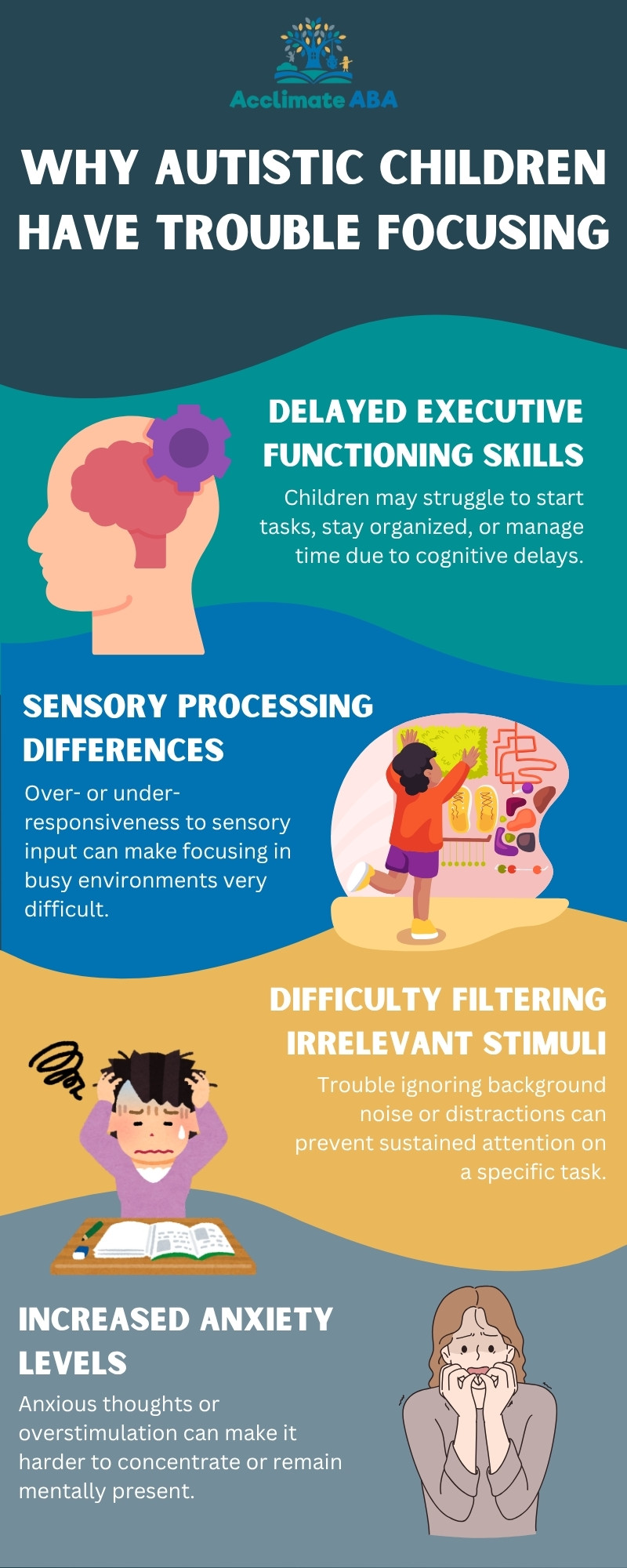Key Points:
- Attention span issues in autism often stem from sensory processing challenges, executive functioning delays, or anxiety.
- Effective strategies include structured routines, visual supports, and breaking tasks into smaller steps.
- ABA therapy can significantly support focus-building by using personalized, data-driven techniques.
Improving attention span in autism is a common challenge, with research showing that up to 70% of individuals with autism also meet criteria for ADHD, a condition closely tied to focus and impulse control difficulties. This overlap means many autistic children experience struggles with sustaining attention, especially in noisy or unstructured settings.
In this article, we’ll go over the causes of attention span issues in autism and walk through practical strategies parents and professionals can use at home or in therapy. With the right supports—like visual aids, structured routines, and ABA techniques—many children can make real progress in building focus.
What Are Attention Span Issues in Autism?
Attention span issues in autism involve difficulty sustaining focus or shifting attention appropriately in different settings. This can lead to challenges in school, play, and daily activities.
While neurotypical children might naturally learn to focus over time, children with autism may need explicit supports to improve attention control. These attention challenges may look different depending on a child’s age, co-occurring conditions (like ADHD), and the environment.
Why Do Children With Autism Have Trouble Focusing?
Attention challenges in autism are rarely due to “bad behavior.” They are often the result of underlying differences in brain function. Executive functioning—which helps with task initiation, working memory, and attention control—is typically affected in individuals on the spectrum.
In many cases, focusing is also impacted by sensory sensitivities. A noisy classroom or a visually cluttered area can overwhelm the child’s senses, leading to overstimulation or social withdrawal.
Common contributors include:
When Should Parents Seek Help for Attention Difficulties?
Parents should seek help when attention difficulties consistently affect learning, daily routines, or social interactions. Signs like frequent task avoidance, meltdowns during structured activities, or ongoing struggles in school may signal the need for support.
Consulting with a developmental pediatrician, psychologist, or Board Certified Behavior Analyst (BCBA) can provide clarity and next steps. Early intervention is key—professional guidance can help uncover underlying causes and lead to personalized strategies that improve focus and overall development.
How Can You Improve Attention Span in Autism at Home?
Improving focus is possible with the right strategies tailored to the child’s needs. The key is to support the child’s brain by reducing distractions, increasing clarity, and building stamina through practice.
Here are several evidence-based methods:
1. Use Visual Schedules and Timers
Visual supports provide structure and predictability, helping children anticipate transitions and stay on task with less anxiety or confusion.
2. Break Tasks into Manageable Steps
Simplifying tasks into smaller parts reduces overwhelm, supports executive functioning, and helps children build confidence as they complete each step.
3. Limit Sensory Distractions
Minimizing overwhelming sensory input—like noise or bright lights—helps children stay regulated and better able to focus on learning or interaction.
4. Reinforce Focused Behavior
Offering praise, rewards, or token systems encourages on-task behavior and builds positive associations with sustained attention.
5. Build Attention Stamina Gradually
Start with short intervals and slowly extend them to strengthen attention span over time without causing frustration or fatigue.
6. Use Movement Breaks
Short physical activities between tasks help reset the nervous system, regulate energy, and prepare the brain to focus again.
7. Incorporate Special Interests
Using topics or objects your child enjoys increases motivation, engagement, and willingness to participate in focused learning activities.
What Role Does ABA Therapy Play in Improving Attention Span?
ABA therapy plays a key role in improving attention span by using structured, individualized strategies to teach focus-related skills. Techniques like Discrete Trial Training (DTT), positive reinforcement, and task analysis help break down attention tasks into manageable steps.
Therapists track progress through data and adjust interventions to meet the child’s needs. By reinforcing sustained attention, minimizing distractions, and gradually building stamina, ABA helps children stay engaged across various settings—school, home, and social environments. These evidence-based practices support long-term gains in focus, independence, and learning readiness.
Daily Routines That Support Attention Growth
Consistency plays a big role in helping children focus better. Incorporating attention-building strategies into everyday routines makes progress more sustainable. Below are some examples of daily practices you can incorporate into your child’s routine:
1. Morning Visual Schedules
Starting the day with a picture-based schedule helps children anticipate what’s next. This predictability reduces stress and builds focus by providing a clear, structured path through daily activities.
2. Predictable Mealtimes and Breaks
Having consistent times for meals and rest creates a dependable routine. This regularity supports emotional regulation and keeps children better prepared for focused learning or therapeutic tasks afterward.
3. Transition Cues with Timers or Music
Using timers or songs to signal transitions helps children shift attention smoothly between tasks. These cues provide gentle structure and reduce confusion, promoting better engagement throughout the day.
4. Short Learning Sessions
Breaking activities into short, manageable segments prevents overwhelm. Frequent, successful task completion increases motivation and gradually extends a child’s attention span in both academic and home environments.
5. Embed Supports in Daily Life
Incorporating visual tools and focus strategies into daily routines helps children practice attention skills naturally. Repetition across different settings makes these strategies more effective and lasting.
The more these supports are embedded into the day, the easier it becomes for the child to succeed.
Build Lasting Skills With ABA Therapy
If your child is struggling with attention span issues, early intervention and consistent strategies can make a meaningful difference. ABA therapy helps children build foundational attention skills through evidence-based practices that are customized to each child’s profile.
Acclimate ABA offers professional ABA therapy in Utah, working with families to improve focus, reduce problem behaviors, and teach vital life skills through structured, compassionate care. Get in touch with us to begin personalized therapy for your child’s attention development!



